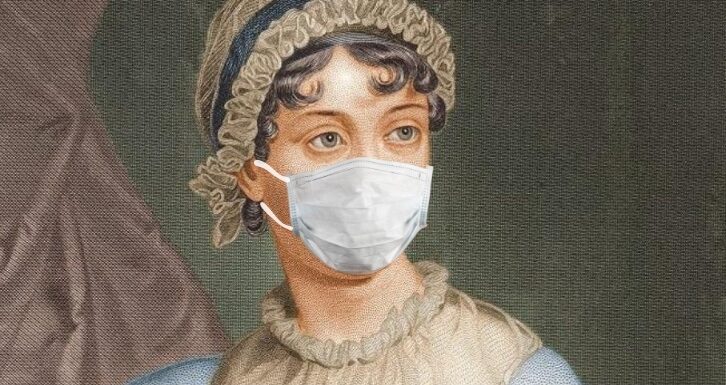
From Austen to Larkin: Why Writers Could Be More Prone to Hypochondria
Caroline Crampton Considers the Intersection of Creative Pursuits and Health Anxiety
Hypochondria is an extremely isolating condition. Afraid of being mocked or dismissed for our anxieties about our health, we hypochondriacs can be inclined to keep it all inside. It can be a lonely way to exist. Even the word “hypochondria” carries the substantial baggage and stigma borne of centuries of ridicule—“health anxiety” is the preferred term today. My own anxieties began with a cancer diagnosis when I was 17.
Five years later when I was declared cured, I couldn’t let go of the concern that the disease would return. That thought pattern then began to apply itself to feelings and symptoms that definitely weren’t cancer-adjacent, until I was a full-blown hypochondriac. Although it is archaic and sometimes stigmatized, I like that word because of the historical connections it brings. It can make me feel less alone with my worries.
It wasn’t until I started searching for my fellow hypochondriacs in the pages of my books that I began to find something like a community. “Hypochondriac” isn’t an official designation that appears frequently, but digging into memoirs, letters and autobiographies can reveal the thought patterns and behaviors that I recognize so well. In this way, I built teetering piles of hypochondriacal literary lives, and began to draw comfort from the sheer number of people who had walked this way before me. Here is a small selection of them.
Is there something inherently “writerly” about being constantly anxious about your health?
Robert Burton
Burton was an early seventeenth-century scholar and clergyman who spent most of his life sequestered at Oxford University working on an enormous book called The Anatomy of Melancholy (the version I own is over 1,300 pages long). First published in 1621 and then in five more editions before Burton’s death in 1640, the Anatomy is an attempt to write something like a medical textbook examining the condition of “melancholy,” which was a word used at the time to describe what we would now call depression.
The reason Burton was so interested in melancholy was that he had substantial experience of it himself. “I write of melancholy, by being busy to avoid melancholy,” he writes. He had received his own diagnosis of hypochondriacal melancholy when he was a young man, after suffering for months with “general malaise” and stomach problems, and studying melancholy became his life’s work. In the Anatomy, though, he does caution his reader against spending too much time immersed in the contemplation of their melancholy because this can do the sufferer “more harm than good.” Since he spent decades doing little else, this has the ring of something learned from bitter experience.
Jane Austen and her mother
Jane Austen herself was not a hypochondriac, but there are so many hypochondriacs in her fiction that I was sure she had to have personal experience of the condition. From Mrs. Bennet in Pride and Prejudice to Mary Musgrove in Persuasion to Mr. Woodhouse in Emma to her entire unfinished novel Sanditon, highlighting the absurdity of hypochondria is a major theme of her work.
And indeed, Jane did have a hypochondriac very close to home. Her mother, Cassandra Leigh Austen, suffered throughout her life with ailments that Jane felt were “chiefly in her head.” Mrs. Austen’s symptoms seemed to vary according to mood and season; at one point she had “an asthma, a dropsy, water in her chest, and a liver disorder” and later on in her life she suffered from terrible biliousness. She has been described by critics as “a lifelong hypochondriac” of the kind who always has the excuse of their health to prevent them doing anything unpleasant, but can stage a miraculous recovery when a congenial activity is proposed—not unlike Mrs. Bennet, when she learns that one of her unmarried daughters is engaged.
Elizabeth Barrett Browning
There is no doubt that Elizabeth Barrett Browning struggled greatly with her health throughout her life. Between 1821-2 and 1837-46, she was considered an invalid by her family circle and experienced disabling symptoms like intense pains in her head and back along with some loss of mobility. Doctors could find no cause for her agony, though, and thus there was always the lingering doubt that her problems stemmed from actual organic disease rather than just her mind.
The pattern of her life also seems to support this hypothesis. For the first four decades of her life she lived a very quiet life dominated by sickness. Then after her marriage to Robert Browning in 1846, she was suddenly able to travel widely in Europe, survive four miscarriages and bring up a son all while producing some of her best literary work. This sudden change in her capabilities once she was in a loving relationship, away from the influence of her extremely dominant father, and able to live a more independent life, has convinced many biographers down the years that her problems were mostly mental, not physical, in origin. But, I would argue, this doesn’t mean they were not “real.”
Philip Larkin
Larkin was a lifelong hypochondriac who was convinced that he would die at the same age as his father—sixty-three. He was never a strong child and had poor eyesight from an early age, growing up into an ungainly man who always looked older than his years. Robert Lowell met Larkin when he was fifty, and wrote to Elizabeth Bishop that T.S. Eliot, who was forty years older, looked younger than Larkin did.
In 1955, when he was thirty-three, Larkin’s mother spent a month in hospital suffering from a condition no doctor could diagnose, and as soon as she was better her son followed suit. Tests and x-rays revealed nothing and he eventually recovered, but he came away from the experience with a morbid fear of his throat becoming constricted or blocked. It became his habit before every meal to drink large glasses of water so as to open his throat sufficiently to swallow food.
His fears of illness and death became a constant theme of his poetry. “Dockery and Son” form 1963’s The Whitsun Weddings contains these immortal lines: “Life is first boredom, then fear. / Whether or not we use it, it goes.” Two years before, he had collapsed at work and been carried to an ambulance unconscious and incontinent, but once again tests failed to find anything. One of his symptoms was “being aware of my right eye.” He wrote to his lover Monica Jones from the hospital: “I’m afraid I’m seriously ill, & really this is all that’s in my mind, and nobody can give me any comfort.”
More than anything, hypochondria feels like a very human condition.
The difficult thing to grapple with regarding Larkin’s hypochondria is that he was, in some ways, right to be afraid. After years of feeling like his throat was closing, it was a diagnosis of esophageal cancer that lead to his death in 1985, at the age of sixty-three, just as he had feared.
Tennessee Williams
Williams is a rare example of someone who was labelled in public as a hypochondriac, in no less a place than his New York Times obituary from 1983. “A monumental hypochondriac, he became obsessed with sickness, failure and death,” it reads. In his notebooks, Williams had recorded near-daily updates about his health for years. A lot of his concerns centered around is stomach, with phrases like “sickish feeling in the stomach,” “felt rotten all day,” “general uneasiness” and “touch of nausea” recurring throughout.
He was aware of his health anxieties, too. In 1938, he starts to develop what he calls “heart neurosis” and expresses fear that it is the beginning of the end. But at the same time, he is aware he is being “silly.” “What makes all this so stupid is that the fear is so much worse than the thing feared—the slight heart defect, however actual, would cause me little discomfort—no actual pain—if I were not afraid of it.” He also often refers to himself as “the patient” in a wry, self-aware way. This doesn’t stop him from panicking every time he feels something like “sudden, jolting pains” in his head, though.
Geoff Dyer
Dyer has always been “keenly aware of the threat of injury or illness,” according to his friend of years, Andrew Anthony, and has long been prone to thinking that he has “too many ailments.” Dyer’s 1997 book Out of Sheer Rage, which documents his failed attempt to write a biography of D.H. Lawrence, also became a record of his own anxieties about his health. Late on in the book after returning from a trip to Oaxaca (where Lawrence himself had been quite ill) Dyer finally gives his own “symptomless illness” a name. “I am suffering from a pathological dread of getting ill, a phantom hypochondria: I haven’t had a cold for over a year now and the longer I go without getting one the more dreadful the prospect becomes,” he writes, before continuing to analyze his own relationship with illness and fear of illness for a few more pages.
The sheer variety of literary hypochondriacs begs the question: are writers more prone to this condition? Is there something inherently “writerly” about being constantly anxious about your health? It does feel like there could be something fundamentally creative about it—the imagination required to so thoroughly experience imaginary illnesses could also be an attribute writers are more likely to have. But then there is also the stark fact that great writers are just more likely to have their thoughts and their work preserved and curated. Perhaps we are just more able to access the hypochondria of famous writers. Maybe there would be more written records of hypochondria if we cherished the writing of more people. More than anything, hypochondria feels like a very human condition: we are alive now, in this second, so we fear that in the next one illness will strike. Something will get me in the end, after all.
__________________________________

A Body Made of Glass: A Cultural History of Hypochondria by Caroline Crampton. is available from Ecco, an imprint of HarperCollins Publishers.
Caroline Crampton
Caroline Crampton is a writer and reviewer who covers a wide variety of subjects for the Guardian, the Spectator, the Mail On Sunday, and other publications. Her first book, The Way to the Sea, was published by Granta in 2019. She appears regularly as a critic on BBC Radio 4. She lives in Merseyside, England.



















